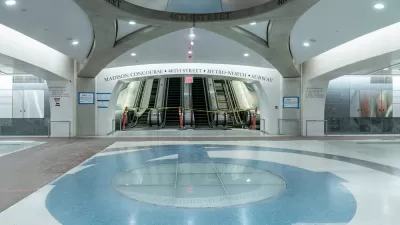Champions of an ambitious ongoing project to provide a rail link for Long Island Rail Road trains to the East Side of Manhattan got a dose of bad news this week, as it was announced the project is facing significant delays and cost overruns.
The past couple of years have seen a flood of bad news for efforts to better integrate New York City's rail hubs with regional commuters and intercity passengers. A year and a half ago, Chris Christie, the newly elected governor of New Jersey, terminated plans to build a desperately needed second rail tunnel underneath the Hudson River. Now comes news that the East Side Access project, which tunnels underneath the East River, is facing a new round of delays and rising cost estimates, reports Colin Moynihan.
"Creating a Long Island Rail Road
link to the East Side of Manhattan will take six years longer to
accomplish than originally expected and will cost nearly $2 billion more
than the initial estimate, Metropolitan Transportation Authority
officials said Monday."
"The new completion date for the project is August 2019, and officials
put the cost at $8.24 billion, up from an estimate of $6.3 billion in
2006. The 2006 estimate came after $2.6 billion in federal financing for
the ambitious project was announced, and transportation officials said
then that they thought the project would be finished by the end of 2013."
Authorities blamed technical challenges and complication from unrelated projects for the delays.
"The East Side Access project requires the construction of new tunnels,
which will be dug beneath the existing tracks in Sunnyside and then
emerge nearby. Authority officials said the profusion of existing
railroad equipment in that area and the sandy soil beneath the network
of tracks had slowed the project."
FULL STORY: L.I.R.R. Plan for East Side Needs More Time and Money

Study: Maui’s Plan to Convert Vacation Rentals to Long-Term Housing Could Cause Nearly $1 Billion Economic Loss
The plan would reduce visitor accommodation by 25,% resulting in 1,900 jobs lost.

North Texas Transit Leaders Tout Benefits of TOD for Growing Region
At a summit focused on transit-oriented development, policymakers discussed how North Texas’ expanded light rail system can serve as a tool for economic growth.

Why Should We Subsidize Public Transportation?
Many public transit agencies face financial stress due to rising costs, declining fare revenue, and declining subsidies. Transit advocates must provide a strong business case for increasing public transit funding.

How to Make US Trains Faster
Changes to boarding platforms and a switch to electric trains could improve U.S. passenger rail service without the added cost of high-speed rail.

Columbia’s Revitalized ‘Loop’ Is a Hub for Local Entrepreneurs
A focus on small businesses is helping a commercial corridor in Columbia, Missouri thrive.

Invasive Insect Threatens Minnesota’s Ash Forests
The Emerald Ash Borer is a rapidly spreading invasive pest threatening Minnesota’s ash trees, and homeowners are encouraged to plant diverse replacement species, avoid moving ash firewood, and monitor for signs of infestation.
Urban Design for Planners 1: Software Tools
This six-course series explores essential urban design concepts using open source software and equips planners with the tools they need to participate fully in the urban design process.
Planning for Universal Design
Learn the tools for implementing Universal Design in planning regulations.
City of Santa Clarita
Ascent Environmental
Institute for Housing and Urban Development Studies (IHS)
City of Grandview
Harvard GSD Executive Education
Toledo-Lucas County Plan Commissions
Salt Lake City
NYU Wagner Graduate School of Public Service



























